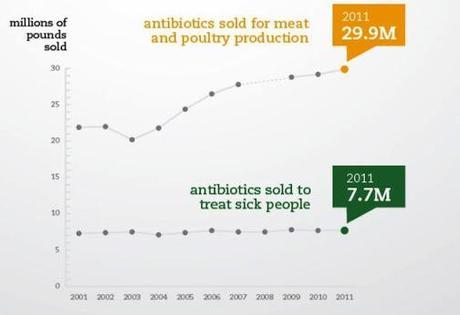If there ever was a headline that could get you to check the labels on your food, it’d be this one. The Pew Charitable Trust has a new infographic out, using FDA data, that shows the sheer volume of antibiotics the meat industry pumps into animals.

Pew Foundation
So, that’s horrifying. But, according to Mother Jones, here’s the best part: these antibiotic stuffed animals are perfect breeding grounds for antibiotic resistant pathogens! What fun:
• Of the Salmonella on ground turkey, about 78% were resistant to at least one antibiotic and half of the bacteria were resistant to three or more. These figures are up compared to 2010.
• Nearly three-quarters of the Salmonella found on retail chicken breast were resistant to at least one antibiotic. About 12% of retail chicken breast and ground turkey samples were contaminated with Salmonella.
• Resistance to tetracycline [an antibiotic] is up among Campylobacter on retail chicken. About 95% of chicken products were contaminated with Campylobacter, and nearly half of those bacteria were resistant to tetracyclines. This reflects an increase over last year and 2002.
There is fix to this issue, however. The “Preservation of Antibiotics for Medical Treatment Act,” according to the Union of Concerned Scientists would:
Within two years of enactment, the Preservation of Antibiotics for Medical Treatment Act (PAMTA) would require the Food and Drug Administration (FDA) to re-review the approvals it previously issued for animal feed uses of the seven classes of antibiotics that are important to human medicine. The approvals would be canceled for any antibiotics that are found to be unsafe from a resistance point of view.
If you’d like to take action, Pew has a website set up with more information if you are interested in contacting Congress. You can also be diligent in checking packaging at the grocery store. Buy organic or non-antibiotic products. Many restaurants will also point out if they use meat without these drugs. Chipotle is a major chain that comes to mind.
Yes, they sometimes cost more, but that’s the point: the meat industry does this to lower costs. The cost of meat is kept artificially low in the US. If the meat industry had to absorb the healthcare and environmental costs associated with their practices, that would be a different story. This is a perfect example of externalizing costs.
At any rate, I hope you are sufficiently disgusted by this to be more aware of what you put in your body.
